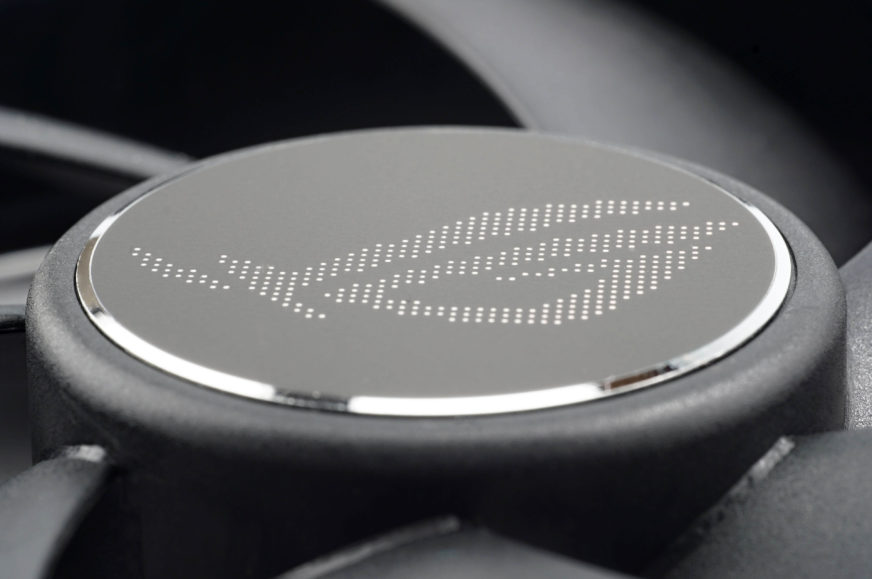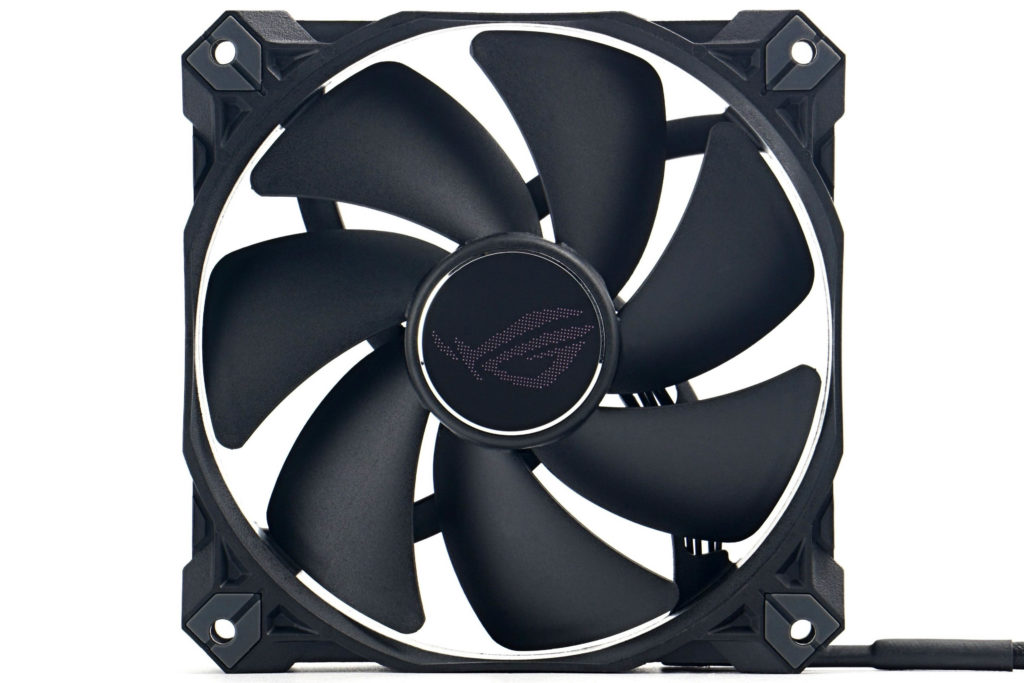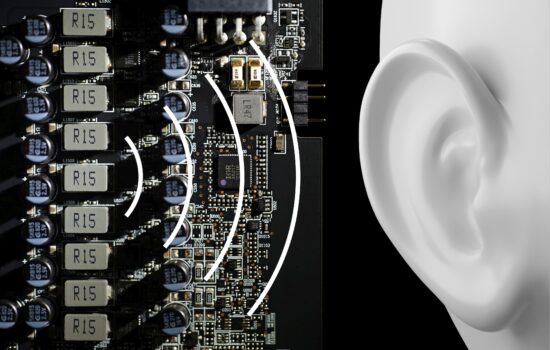Asus ROG Strix XF120 in detail
The first and still the only Asus fan that is on sale individually may be a good choice. But you can also get burnt. It depends on what you want to use it for. In the right context, it gives attractive results, and the impression of a very decent fan is spoiled mainly by pointless design details or sugar-coating the specs. Anyway, you can see that compared to the more ordinary fans from the last test, the Strix is a bit of a different class.
The XF120 fan falls categorically under ROG (Strix series), so it should be a more decent product that should stand out with high quality standards. However, this fan doesn’t break the price ceiling and it can be bought for some 23 euros, which is less than you pay for top models from competing manufacturers. However, Asus pretends to have a better fan up its sleeve overall despite the lower price. It claims that the XF120 is optimized for all types of applications (as a system fan or radiator fan), even reaching static pressures as high as 3.07 mm H2O, which is unheard of for 120 mm fans with speeds below 2000 rpm.
The key thing for the XF120 is also the contactless magnetic bearings, which are supposed to lower the noise level and make the fan last for a long time. The mean time between failures (MTBF) is quoted by Asus at up to 45 years. Too bad this longevity is not covered by a lifetime warranty, which is “only” five years.
| Brand and model of fan | Paper specicifations * | Price [EUR] | ||||||||
| Format (and thickness) in mm | Connecting | Speed [rpm] | Airflow [m3/h] | Static pressure [mm H2O] | Noise level [dBA] | Bearings | MTBF [h] | |||
| Motor | RGB LED | |||||||||
| Asus ROG Strix XF120 | 120 (25) | 4-pin (PWM) | N/A | 1800 | 106.19 | 3.07 | 22.5 | „MagLev“ | 400 000 | 23 |
| Akasa Vegas X7 | 120 (25) | 4-pin (PWM) | 4-pin (12 V) | 1200 | 71.19 | N/A | 23.2 | fluid | 40 000 | 11 |
| Reeven Coldwing 12 | 120 (25) | 4-pin (PWM) | N/A | 300–1500 | 37.54–112.64 | 0.17–1.65 | 6.5–30.4 | sleeve | 30 000 | 12 |
| Reeven Kiran | 120 (25) | 4-pin (PWM) | shared | 400–1500 | 110.10 | 2.95 | 33.6 | fluid | 120 000 | 17 |
| SilentiumPC Sigma Pro 120 PWM | 120 (25) | 4-pin (PWM) | N/A | 500–1600 | 79.00 | N/A | 15.0 | hydraulic | 50 000 | 7 |
| SilentiumPC Sigma Pro Corona RGB 120 | 120 (25) | 4-pin (PWM) | 4-pin (12 V) | 1500 | 56.58 | N/A | N/A | hydraulic | 50 000 | 12 |
| SilverStone SST-AP121 | 120 (25) | 3-pin (DC) | N/A | 1500 | 60.08 | 1.71 | 22.4 | fluid | 50 000 | 18 |
| SilverStone SST-FQ121 | 120 (25) | 7-pin (PWM) | N/A | 1000–1800 | 114.68 | 0.54–1.82 | 16.4–24.0 | PCF (fluid) | 150 000 | 20 |
| Xigmatek XLF-F1256 | 120 (25) | 3-pin (DC) | N/A | 1500 | 103.64 | N/A | 20.0 | „long-life“ | 50 000 | 16 |
* When reading performance values, a certain amount of tolerance must always be taken into account. For maximum speeds, ±10% is usually quoted, minimum speeds can vary considerably more from piece to piece, sometimes manufacturers will overlap by as much as ±50%. This must then also be adequately taken into account for air flow, static pressure and noise levels. If only one value is given in a table entry, this means that it always refers to the situation at maximum speed, which is achieved at 12 V or 100% PWM intensity. The manufacturer does not disclose the lower limit of the performance specifications in its materials in that case. The price in the last column is always approximate.
The rotor consists of seven larger blades with rounded corners. The circular centre of the rotor has a relatively small diameter (39 mm), which means that there is quite a large area/section per blade. The blades are quite massive, in all axes, so they are also quite wide. Apart from the rounded corners, you won’t discover much from the front.
However, after fitting the nylon dust filter, you’ll find that the rotor is quite tall and the frame only exceeds it by a hair. This causes the rotoe to brush against the screen of the nylon filter (you can still use a plastic one, as it holds its shape and doesn’t “cave in”) and thus can be described as incompatible.
However, as a system fan for a proper computer with a fine filter, the XF120 is not suitable for another reason, which we will gradually work our way to.
The grooves show on the back – the flared part at the ends is in each blade. These grooves are to direct the airflow and thus increase efficiency.
The finish of some of the blades is a bit striking. The blades all have a fine sandblasted finish from the front, from the back there are only four with it. The remaining four have polishing marks and it gives an unfinished, sloppy impression much like once the overly long screws on the Radeon RX 5700s. In this case it won’t affect functionality though, the rotor is balanced well, but it doesn’t leave a good impression. It was definitely not the intention, this applies to all retail samples.
The fan has rubber pads in the corners to reduce vibration, and you can also use rubber spikes to mount it in the cabinet. We’ll test these later in a big comparison test of anti-vibration mounts. The accessories are then just self-tapping screws and a Y fork. The extension cable is not supplied in the package, but you probably won’t miss it. The fan cable itself is quite long, exceeding half a meter.
The decorative touches have not been forgotten either, which include prominent “ROG Strix” lettering on two sides of the fan. These, as well as the motor housing trim on the rotor have a shiny metallic finish.
We can also add that the weight of the fan is average (155 g). That would be all of the design details, there is no need to dissect them more, the important stuff are the test results, which can be found in the following chapters of the article. Study them thoroughly and save the final chapter with our interpretation and evaluation for the end.
- Contents
- Asus ROG Strix XF120 in detail
- The basis of the methodology, the wind tunnel
- Mounting and vibration measurement
- Initial warm-up and speed recording
- Base 7 equal noise levels…
- .. and sound color (frequency characteristic)
- Static pressure measurement…
- … and airflow
- Everything changes with obstacles
- How we measure power draw and motor power
- Measuring the intensity (and power draw) of lighting
- Results: Speed
- Results: Airflow w/o obstacles
- Results: Airflow through a nylon filter
- Results: Airflow through a plastic filter
- Results: Airflow through a hexagonal grille
- Results: Airflow through a thinner radiator
- Results: Airflow through a thicker radiator
- Results: Static pressure w/o obstacles
- Results: Static pressure through a nylon filter
- Results: Static pressure through a plastic filter
- Results: Static pressure through a hexagonal grille
- Results: Static pressure through a thinner radiator
- Results: Static pressure through a thicker radiator
- Results: Static pressure, efficiency by orientation
- Reality vs. specifications
- Results: Frequency response of sound w/o obstacles
- Results: Frequency response of sound with a dust filter
- Results: Frequency response of sound with a hexagonal grille
- Results: Frequency response of sound with a radiator
- Results: Vibration, in total (3D vector length)
- Results: Vibration, X-axis
- Results: Vibration, Y-axis
- Results: Vibration, Z-axis
- Results: Power draw (and motor power)
- Results: Cooling performance per watt, airflow
- Results: Cooling performance per watt, static pressure
- Airflow per euro
- Static pressure per euro
- Results: Lighting – LED luminance and power draw
- Results: LED to motor power draw ratio
- Evaluation
















